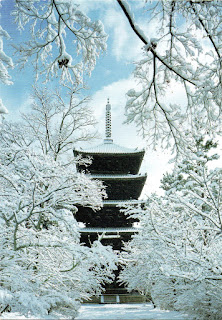If it's true that some of these buildings are very look alike it's also true that they are all very beautiful and impressive! And when the nature does its magic around them it's absolutely gorgeous!
 |
| Tō-ji Temple |
This postcard was sent by Phoebe
Tō-ji (東寺 Tō-ji?) (East Temple) is a Buddhist temple of the Shingon sect in Kyoto, Japan. It once had a partner,Sai-ji (West Temple) and, together, they stood alongside the Rashomon, gate to the Heian capital. It was formally known as Kyō-ō-gokoku-ji (教王護国寺 The Temple for the Defense of the Nation by Means of the King of Doctrines?) which indicates that it previously functioned as a temple providing protection for the nation.
Tō-ji was founded in the early Heian period. The temple dates from 796, two years after the capital moved to Heian-kyō. Together with its partner Sai-ji, and the temple Shingon-in (located in the Heian Palace), it was one of only three Buddhist temples allowed in the capital at the time, and is the only of the three to survive to the present.
The Five-story pagoda of Tō-ji stands 54.8 m high, and is the tallest wooden tower in Japan. It dates from the Edo period, when it was rebuilt by order of the third Tokugawa Shogun, Iemitsu. The pagoda has been, and continues to be, a symbol of Kyoto. Entrance into the pagoda itself is permitted only a few days a year. - in: wikipedia
 |
| Kiyomizu-dera |
This postcard was sent by Jennifer
Kiyomizu-dera (清水寺?), officially Otowa-san Kiyomizu-dera (音羽山清水寺?) is an independent Buddhist temple in eastern Kyoto.
Kiyomizu-dera was founded in the early Heian period. The temple was founded in 778, and its present buildings were constructed in 1633, ordered by the Tokugawa Iemitsu. There is not a single nail used in the entire structure. It takes its name from the waterfall within the complex, which runs off the nearby hills.Kiyomizu means clear water, or pure water. - in: wikipedia
 |
| Ninna-ji Temple |
This postcard was sent by Ai
Ninna-ji was founded in the early Heian period. In 886, Emperor Kōkō ordered the construction of the Nishiyama Goganji Temple to bless the nation and propagate Buddhist teachings, but he did not live to see its completion. Emperor Uda saw the construction to its completion in 888 and named it "Ninna" after the regnal year of the late Emperor Kōkō's reign. From 888 to 1869 it was traditional for reigning Emperors to send a son to the temple to take over as head priest when a vacancy arose. - in: wikipedia
 |
| Byōdō-in |
This postcard was sent by Phoebe
This temple was originally built in 998 in the Heian period as a rural villa of high-ranking courtier Minamoto no Shigenobu, Minister of the Left. The property was purchased from Minamoto no Shigenobu's wife after he died by Fujiwara no Michinaga, one of the most powerful members of the Fujiwara clan. The villa was made into a Buddhist temple by Fujiwara no Yorimichi in 1052. - in: wikipedia
 |
| Kinkaku-ji Temple |
This postcard was sent by Juka
Kinkaku-ji (金閣寺?, lit. "Temple of the Golden Pavilion"), officially named Rokuon-ji (鹿苑寺?, lit. "Deer Garden Temple"), is a Zen Buddhist temple in Kyoto, Japan.
 |
| Kinkaku-ji Temple |
This postcard arrived through the official Postcrossing site
It is one of the most popular buildings in Japan, attracting a large number of visitors annually. It is designated as a National Special Historic Site and a National Special Landscape, and it is one of 17 locations comprising the Historic Monuments of Ancient Kyoto which are World Heritage Sites. - in: wikipedia
 |
| Nijō Castle |
This postcard was sent by Claus
Nijō Castle (二条城 Nijō-jō?) is a flatland castle in Kyoto, Japan. The castle consists of two concentric rings (Kuruwa) of fortifications, the Ninomaru Palace, the ruins of the Honmaru Palace, various support buildings and several gardens. The surface area of the castle is 275,000 square meters, of which 8000 square meters is occupied by buildings. - in: wikipedia
The 17 monuments (in red what I already have):
- Kamowakeikazuchi Shrine aka Kamigamo Shrine
- Kamomioya Shrine aka Shimogamo Shrine
- Kyōōgokoku-ji aka Tō-ji
- Kiyomizu-dera
- Enryaku-ji
- Daigo-ji
- Ninna-ji
- Byōdō-in
- Ujigami Shrine
- Kōzan-ji
- Saihō-ji aka Moss temple
- Tenryū-ji
- Rokuon-ji aka Temple of the Golden Pavilion
- Jishō-ji aka Temple of the Silver Pavilion
- Ryōan-ji (The Temple of the Peaceful Dragon)
- Nishi Hongan-ji
- Nijō Castle































